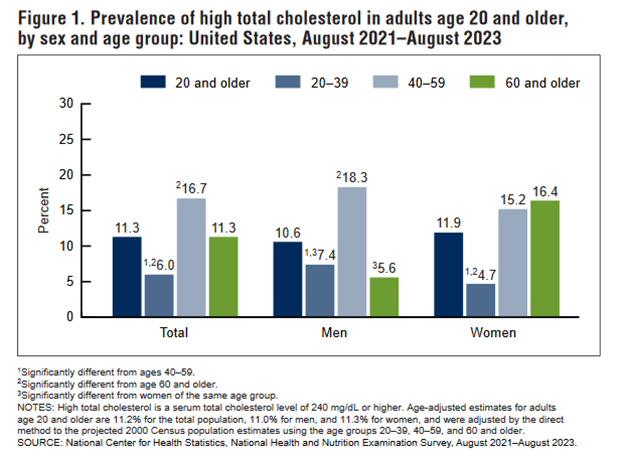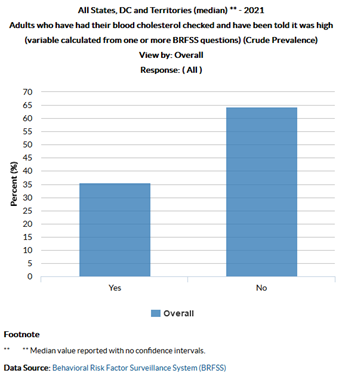Online Course
NRSG 780 - Health Promotion and Population Health
Module 2: Determinants of Health
Modifiable Lifestyle Risk Factors: Elevated Serum Cholesterol
Another modifiable lifestyle risk factor for the leading causes of death is elevated serum cholesterol. This subtopic will focus on the effects, risks, trends and cultural differences associated with elevated serum cholesterol.
In 1961, the Framingham Heart Study also identified elevated serum cholesterol for the first time as a risk factor in the development of coronary heart disease in 1961(1).
- Kannel, W., Dawber, T.R., Kagan, A., Revotskie, N., & Stokes, J. (1961). Factors of risk in the development of coronary heart disease—Six year follow-up experience. Annals of Internal Medicine, 55(1), 33-50.
The Western Electric Study of the relationship between diet, serum cholesterol and mortality followed nearly 2000 middle-aged men between 1960 and 1980. The study concluded that the lipid composition of diet affects cholesterol levels and increases the risk of coronary death (2).
- Shekelle, R., Shyrock, A., Paul, O., Lepper, M., Stamler, J., Liu, S., & Raynor, W. (1981). Diet, serum cholesterol and death from coronary heart disease “The Western Electric Study”, New England Journal of Medicine, 304(2), 65-70.
The Lipid Research Clinics Coronary Primary Prevention Trial studied the efficacy of cholesterol lowering in reducing risk of coronary heart disease in nearly 4000 middle-aged men over an average of more than seven years. Results demonstrated that reducing total cholesterol by lowering LDL-C levels can diminish coronary heart disease morbidity and mortality. (3)
- Lipid Research Clinics Program, The Lipid Research Clinics Coronary Primary Prevention Trial results I. Reduction in incidence of coronary heart disease, Journal of American Medical Association, 251(3), 351-364.
Risk of Elevated Blood Cholesterol
Elevated blood cholesterol significantly increases the risk of coronary heart disease and stroke.
As cholesterol levels increase, heart disease mortality rates increase.

Differences in Cholesterol by Gender and Age
NHANES data indicate that over the last several decades the average serum cholesterol levels for men and women are declining.


Source: https://www.cdc.gov/nchs/data/databriefs/db515.pdf
Cultural Differences in Cholesterol
Cultural differences in serum cholesterol levels are significant. Notice how the average serum cholesterol in Japan is under 150 and the curve is quite narrow. Compare these data to Finland, where the mean is 250 and the population levels range from 150 to 350.

Cholesterol levels in different countries vary even in young children ages 5 to 9 years. Notice the differences between the mean levels in Mexico as compared to the U. S.

Data from the landmark Ni-Hon-San study show that cholesterol levels are not genetically determined alone. Studies of Japanese natives who migrated to Hawaii showed that their cholesterol levels eventually matched those of the Hawaiian islanders. Cholesterol levels of those who migrated to the San Francisco area eventually reflected the levels of the average American. Studies of each of the migrant populations showed that they adopted the dies of their new homelands.

 Data from the Behavioral Risk Factor Surveillance System show that in 2019 over 85% of Americans have had their cholesterol checked and over 35% were told it was high.
Data from the Behavioral Risk Factor Surveillance System show that in 2019 over 85% of Americans have had their cholesterol checked and over 35% were told it was high.

Question:
Given the relationship between diet and cholesterol levels and mortality, can you identify possible interventions at the community, provider and policy level that may help to reduce the level of elevated serum cholesterol in the population?
This website is maintained by the University of Maryland School of Nursing (UMSON) Office of Learning Technologies. The UMSON logo and all other contents of this website are the sole property of UMSON and may not be used for any purpose without prior written consent. Links to other websites do not constitute or imply an endorsement of those sites, their content, or their products and services. Please send comments, corrections, and link improvements to nrsonline@umaryland.edu.